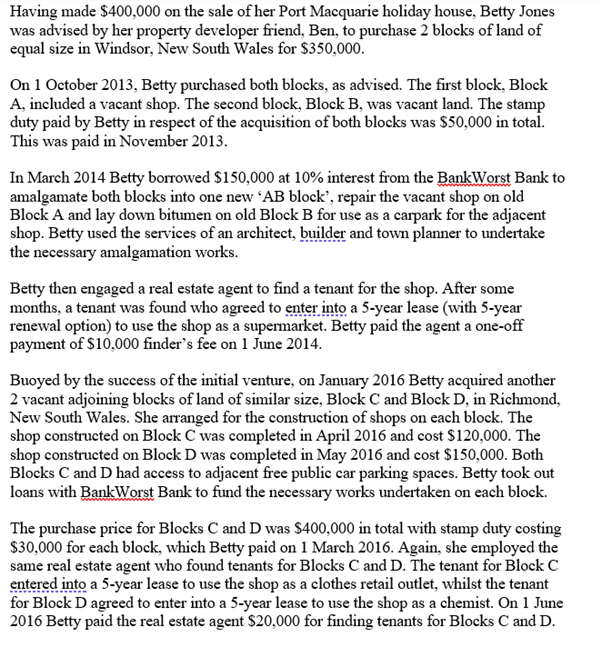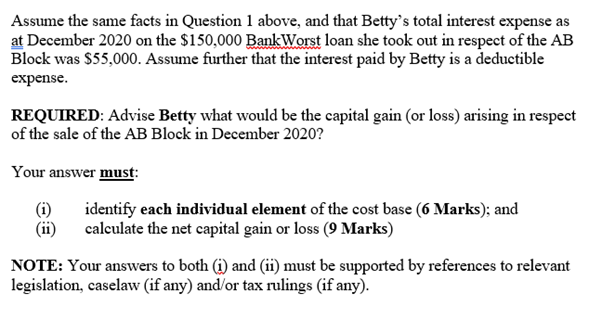


Having made $400,000 on the sale of her Port Macquarie holiday house, Betty Jones was advised by her property developer friend, Ben, to purchase 2 blocks of land of equal size in Windsor, New South Wales for $350,000. On 1 October 2013, Betty purchased both blocks, as advised. The first block, Block A, included a vacant shop. The second block, Block B, was vacant land. The stamp duty paid by Betty in respect of the acquisition of both blocks was $50,000 in total. This was paid in November 2013. In March 2014 Betty borrowed $150,000 at 10% interest from the BankWorst Bank to amalgamate both blocks into one new 'AB block, repair the vacant shop on old Block A and lay down bitumen on old Block B for use as a carpark for the adjacent shop. Betty used the services of an architect, builder and town planner to undertake the necessary amalgamation works. Betty then engaged a real estate agent to find a tenant for the shop. After some months, a tenant was found who agreed to enter into a 5-year lease (with 5-year renewal option) to use the shop as a supermarket. Betty paid the agent a one-off payment of $10,000 finder's fee on 1 June 2014. Buoyed by the success of the initial venture, on January 2016 Betty acquired another 2 vacant adjoining blocks of land of similar size, Block C and Block D, in Richmond, New South Wales. She arranged for the construction of shops on each block. The shop constructed on Block C was completed in April 2016 and cost $120,000. The shop constructed on Block D was completed in May 2016 and cost $150,000. Both Blocks C and D had access to adjacent free public car parking spaces. Betty took out loans with BankWorst Bank to fund the necessary works undertaken on each block. The purchase price for Blocks C and D was $400,000 in total with stamp duty costing $30,000 for each block, which Betty paid on 1 March 2016. Again, she employed the same real estate agent who found tenants for Blocks C and D. The tenant for Block C entered into a 5-year lease to use the shop as a clothes retail outlet, whilst the tenant for Block D agreed to enter into a 5-year lease to use the shop as a chemist. On 1 June 2016 Betty paid the real estate agent $20,000 for finding tenants for Blocks C and D. In April 2020, Betty was advised by the tenant of the shop on the AB Block that they will not be renewing their lease when it expires in June 2020 as the Covid-19 crisis had significantly and adversely impacted their business. After four months of unsuccessfully trying to find a new tenant for AB Block, Betty decided to sell the land and shop. She spent a further $25,000 in October 2020 on repainting the shop on AB Block. In December 2020, Betty sold AB Block for $650,000. The agent's fee on the sale was $35,000. Assume the same facts in Question 1 above, and that Betty's total interest expense as at December 2020 on the $150,000 BankWorst loan she took out in respect of the AB Block was $55,000. Assume further that the interest paid by Betty is a deductible expense. REQUIRED: Advise Betty what would be the capital gain (or loss) arising in respect of the sale of the AB Block in December 2020? Your answer must (i) identify each individual element of the cost base (6 Marks); and calculate the net capital gain or loss (9 Marks) NOTE: Your answers to both (1) and (ii) must be supported by references to relevant legislation, caselaw (if any) and/or tax rulings (if any). Having made $400,000 on the sale of her Port Macquarie holiday house, Betty Jones was advised by her property developer friend, Ben, to purchase 2 blocks of land of equal size in Windsor, New South Wales for $350,000. On 1 October 2013, Betty purchased both blocks, as advised. The first block, Block A, included a vacant shop. The second block, Block B, was vacant land. The stamp duty paid by Betty in respect of the acquisition of both blocks was $50,000 in total. This was paid in November 2013. In March 2014 Betty borrowed $150,000 at 10% interest from the BankWorst Bank to amalgamate both blocks into one new 'AB block, repair the vacant shop on old Block A and lay down bitumen on old Block B for use as a carpark for the adjacent shop. Betty used the services of an architect, builder and town planner to undertake the necessary amalgamation works. Betty then engaged a real estate agent to find a tenant for the shop. After some months, a tenant was found who agreed to enter into a 5-year lease (with 5-year renewal option) to use the shop as a supermarket. Betty paid the agent a one-off payment of $10,000 finder's fee on 1 June 2014. Buoyed by the success of the initial venture, on January 2016 Betty acquired another 2 vacant adjoining blocks of land of similar size, Block C and Block D, in Richmond, New South Wales. She arranged for the construction of shops on each block. The shop constructed on Block C was completed in April 2016 and cost $120,000. The shop constructed on Block D was completed in May 2016 and cost $150,000. Both Blocks C and D had access to adjacent free public car parking spaces. Betty took out loans with BankWorst Bank to fund the necessary works undertaken on each block. The purchase price for Blocks C and D was $400,000 in total with stamp duty costing $30,000 for each block, which Betty paid on 1 March 2016. Again, she employed the same real estate agent who found tenants for Blocks C and D. The tenant for Block C entered into a 5-year lease to use the shop as a clothes retail outlet, whilst the tenant for Block D agreed to enter into a 5-year lease to use the shop as a chemist. On 1 June 2016 Betty paid the real estate agent $20,000 for finding tenants for Blocks C and D. In April 2020, Betty was advised by the tenant of the shop on the AB Block that they will not be renewing their lease when it expires in June 2020 as the Covid-19 crisis had significantly and adversely impacted their business. After four months of unsuccessfully trying to find a new tenant for AB Block, Betty decided to sell the land and shop. She spent a further $25,000 in October 2020 on repainting the shop on AB Block. In December 2020, Betty sold AB Block for $650,000. The agent's fee on the sale was $35,000. Assume the same facts in Question 1 above, and that Betty's total interest expense as at December 2020 on the $150,000 BankWorst loan she took out in respect of the AB Block was $55,000. Assume further that the interest paid by Betty is a deductible expense. REQUIRED: Advise Betty what would be the capital gain (or loss) arising in respect of the sale of the AB Block in December 2020? Your answer must (i) identify each individual element of the cost base (6 Marks); and calculate the net capital gain or loss (9 Marks) NOTE: Your answers to both (1) and (ii) must be supported by references to relevant legislation, caselaw (if any) and/or tax rulings (if any)









